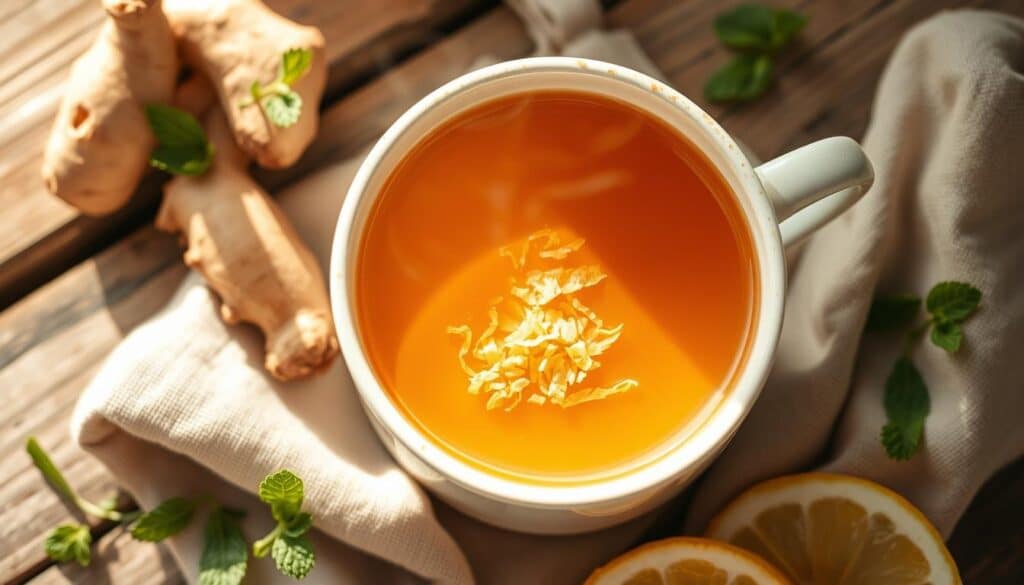Anúncios
Headaches can be debilitating, affecting daily life and productivity. While there are various treatments available, many people prefer herbal remedies for relief. One effective and natural way to alleviate headache symptoms is by consuming specific teas.
Certain herbal teas have been found to provide relief from headache symptoms. These teas work by relaxing tense muscles, improving blood flow, and reducing inflammation. By incorporating these teas into your daily routine, you can potentially reduce the frequency and severity of headaches.
Anúncios
Key Takeaways
- Herbal teas can provide relief from headache symptoms.
- Certain teas relax tense muscles and improve blood flow.
- Incorporating these teas into your daily routine can reduce headache frequency.
- Natural remedies like herbal teas offer an alternative to traditional treatments.
- Headache prevention is possible with consistent consumption of specific teas.
Understanding How Herbal Teas Help with Headaches
With their rich history and diverse applications, herbal teas are increasingly being recognized for their role in headache management. Herbal teas offer a natural approach to alleviating headache symptoms, leveraging the therapeutic properties of various plants.
The Science Behind Plant Compounds and Pain Relief
Herbal teas contain a variety of bioactive compounds that contribute to their pain-relieving properties. For instance, flavonoids and terpenes found in many herbal teas have been shown to possess anti-inflammatory and analgesic effects. These compounds interact with the body’s biological systems to help mitigate headache pain.
Different Headache Types and How Teas Can Help
Headaches can be broadly categorized into tension headaches, migraines, and sinus headaches, among others. Herbal teas can be tailored to address specific types of headaches. For example, teas with calming properties, such as chamomile, can help alleviate tension headaches, while teas with anti-inflammatory properties, like ginger, may be more beneficial for migraines.
Peppermint Tea: A Cooling Solution for Tension Headaches
The cooling properties of peppermint tea make it an ideal choice for those suffering from tension headaches. This refreshing herbal remedy has been used for centuries to alleviate various ailments, and its effectiveness in relieving tension headaches is well-noted.
Active Compounds
Peppermint tea owes its therapeutic benefits to its active compounds, primarily menthol and menthone. These natural analgesics work together to ease muscle tension and improve blood flow, providing relief from headache symptoms. The menthol in peppermint tea also has a calming effect on the muscles, further reducing tension.
- Menthol: Provides a cooling sensation that helps relax muscles.
- Menthone: Contributes to the analgesic and anti-inflammatory properties.
Brewing the Perfect Cup
To maximize the benefits of peppermint tea, it’s essential to brew it correctly. Here are some tips:
- Use fresh peppermint leaves or high-quality tea bags.
- Heat water to a boil, then let it cool for a minute or two before pouring over the tea leaves.
- Steep for 5-7 minutes to allow the active compounds to infuse into the water.
- Strain and enjoy hot, or let it cool and serve over ice.
Research Supporting Peppermint
Research has shown that peppermint tea can be effective in relieving tension headaches. A study published in a reputable medical journal found that the menthol in peppermint tea helped to relax muscles and improve blood flow, thereby reducing headache symptoms. Incorporating peppermint tea into your daily routine could be a valuable step in managing tension headaches.
Ginger Tea: Fighting Inflammation and Migraine Pain

Ginger tea is renowned for its ability to combat inflammation and alleviate the pain associated with migraines. This natural remedy has been used for centuries, and its effectiveness can be attributed to its active compounds.
Anti-inflammatory Properties
Ginger contains powerful anti-inflammatory compounds called gingerols and shogaols. These compounds have been shown to reduce inflammation and alleviate pain. The anti-inflammatory properties of ginger make it an effective natural remedy for migraine relief.
Best Preparation Methods for Maximum Benefits
To maximize the benefits of ginger tea, it’s essential to prepare it correctly. Start by slicing fresh ginger thinly and steeping it in boiling water for 5-10 minutes. You can also add lemon or honey to enhance the flavor. For a more concentrated dose, consider using ginger extracts or powders.
Clinical Studies on Ginger and Migraines
Several clinical studies have investigated the efficacy of ginger in reducing migraine pain. A study published in the Journal of Ethnopharmacology found that ginger extract significantly reduced migraine pain in participants. Another study highlighted ginger’s ability to reduce inflammation, a key factor in migraine development.
Incorporating ginger tea into your daily routine can be a simple and effective way to manage migraine symptoms. With its anti-inflammatory properties and ease of preparation, ginger tea is a natural solution worth considering for those seeking migraine relief.
Chamomile Tea: Calming Stress-Induced Headaches
In the quest for headache relief, chamomile tea emerges as a gentle yet powerful option, particularly for stress-related cases. Stress-induced headaches are a common affliction in today’s fast-paced world, and finding a natural remedy is a priority for many. Chamomile tea, with its soothing effects, offers a promising solution.
Relaxation Benefits of Chamomile
Chamomile tea is renowned for its relaxation benefits, primarily due to its apigenin content, an antioxidant that binds to certain receptors in the brain, promoting relaxation and reducing anxiety. This calming effect can be particularly beneficial for individuals whose headaches are triggered or exacerbated by stress.
Brewing Tips for Optimal Potency
To maximize the benefits of chamomile tea, it’s essential to brew it correctly. Use high-quality, dried chamomile flowers and steep them in boiling water for 5 to 10 minutes. The longer steeping time can enhance the tea’s soothing effects, making it more effective for relaxation and headache prevention.
When to Drink Chamomile for Headache Prevention
Drinking chamomile tea at strategic times can enhance its headache prevention benefits. Consuming a cup in the evening can promote a restful night’s sleep, while having it during stressful periods of the day can help mitigate tension. Regular consumption can lead to a reduction in stress-induced headaches over time.
Lavender Tea: Aromatherapy in a Cup
Among the various herbal teas, lavender stands out for its unique ability to provide relief from headaches through both its scent and consumption. This dual benefit makes lavender tea an attractive option for those seeking natural headache remedies.
Dual Benefits: Aroma and Consumption
Lavender tea offers a distinctive advantage over other herbal teas due to its dual-action relief mechanism. The aroma of lavender is known for its calming effects, which can help reduce stress-induced headaches. When consumed, the active compounds in lavender tea are absorbed into the bloodstream, providing systemic relief from headache symptoms.
The aromatherapy benefits of lavender tea are not just anecdotal; research has shown that inhaling lavender essential oil can decrease anxiety and improve mood, both of which are factors in headache prevention.
Creating a Lavender Tea Ritual for Headache Relief
To maximize the headache relief benefits of lavender tea, creating a ritual around its consumption can be highly effective. Start by selecting a quiet, comfortable space where you can sit and relax without distractions.
Begin your ritual by mindfully preparing your lavender tea. Use high-quality, dried lavender flowers and steep them in hot water for the recommended 5-7 minutes. As you wait, inhale the rising steam to benefit from the aromatherapy effects.
Once your tea is ready, take slow, deliberate sips, focusing on the taste and the calming sensation it brings. This mindful consumption, combined with the tea’s active compounds, can enhance the overall headache relief experience.
Caffeine-Containing Teas: Friend or Foe for Headaches?

Caffeine-containing teas can be a double-edged sword for headache sufferers. While caffeine can sometimes provide relief, it can also trigger or worsen headaches in certain individuals. The key lies in understanding how different caffeine-containing teas affect headache symptoms.
Green Tea: Balanced Caffeine with Antioxidants
Green tea offers a balanced amount of caffeine along with high levels of antioxidants, making it a potentially beneficial choice for headache sufferers. The antioxidants in green tea, such as catechins, may help reduce inflammation that contributes to headaches. With less caffeine than black tea but more than herbal teas, green tea can provide a gentle boost without overloading on caffeine.
Black Tea: When and How to Use for Headache Relief
Black tea contains more caffeine than green tea, which can be beneficial in certain situations for headache relief. For instance, if you’re experiencing a headache due to caffeine withdrawal, a cup of black tea might help alleviate symptoms temporarily. However, it’s crucial to consume black tea in moderation to avoid exacerbating headache issues.
Managing Caffeine Withdrawal Headaches
For those who regularly consume caffeine, sudden withdrawal can lead to headaches. Managing caffeine withdrawal headaches involves gradually reducing caffeine intake rather than stopping abruptly. Incorporating caffeine-containing teas like green or black tea in limited amounts can help mitigate withdrawal symptoms, including headaches, by slowly decreasing caffeine dependence.
In conclusion, caffeine-containing teas like green and black tea can be valuable tools for managing headaches when consumed thoughtfully. By understanding the caffeine content and potential benefits of these teas, individuals can make informed decisions to help alleviate headache symptoms.
- Green tea offers balanced caffeine and antioxidants.
- Black tea can be used for headache relief in moderation.
- Gradual reduction of caffeine intake can help manage withdrawal headaches.
Natural Teas for Headache Prevention and Management
Incorporating natural teas into your daily routine can be a game-changer for headache prevention and management. By adopting a consistent tea-drinking habit, individuals can potentially reduce the frequency and severity of headaches.
Daily Tea Routines for Headache Sufferers
Establishing a daily tea routine can be a simple yet effective strategy for managing headaches. Drinking tea at the same time each day can help regulate bodily functions and potentially reduce headache occurrences. For example, starting the day with a soothing cup of chamomile tea can set a calming tone and help prevent stress-induced headaches.
A well-structured daily tea routine might include a variety of teas, each chosen for its specific benefits. Here’s an example of how to incorporate different teas into your daily schedule:
| Time of Day | Recommended Tea | Benefits |
|---|---|---|
| Morning | Chamomile or Peppermint | Relaxation, digestion |
| Afternoon | Ginger or Green Tea | Anti-inflammatory, antioxidant |
| Evening | Lavender or Chamomile | Promotes sleep, relaxation |
Combining Teas for Enhanced Effects
Combining different teas can enhance their individual benefits and provide even greater relief for headache sufferers. For instance, blending peppermint and ginger teas can create a powerful combination that addresses both tension and inflammation. Experimenting with different tea combinations can help individuals find what works best for their specific headache needs.
Some effective tea combinations include:
- Peppermint and Ginger: For tension and inflammation
- Chamomile and Lavender: For relaxation and stress relief
- Green Tea and Black Tea: For a balanced caffeine boost with antioxidants
Feverfew and Willow Bark: Traditional Medicinal Teas
For centuries, traditional medicinal teas have been a cornerstone in managing headache symptoms, with feverfew and willow bark being two of the most notable herbs. These natural remedies have been used to alleviate headache symptoms, offering a complementary approach to modern medicine.
Feverfew: Historical Use and Modern Research
Feverfew, known scientifically as Tanacetum parthenium, has been used since ancient times for its medicinal properties. Modern research has validated its use in reducing the frequency and severity of migraines. Studies have shown that feverfew extracts can inhibit the release of serotonin, a neurotransmitter involved in migraine attacks.
Willow Bark: Nature’s Aspirin
Willow bark contains salicin, a compound similar to aspirin. It has been used for centuries to reduce pain and inflammation. The mechanism behind willow bark’s effectiveness lies in its ability to inhibit prostaglandins, which are chemicals in the body that cause pain and inflammation.
| Herb | Active Compound | Primary Use |
|---|---|---|
| Feverfew | Parthenolide | Migraine Prevention |
| Willow Bark | Salicin | Pain Relief |
Precautions and Proper Usage
While feverfew and willow bark teas offer potential benefits, it’s crucial to use them correctly. Feverfew can cause allergic reactions in some individuals, and willow bark should be used cautiously by those with bleeding disorders or taking anticoagulant medications. Always consult with a healthcare professional before adding these teas to your regimen.
Key Considerations:
- Start with small doses to test tolerance.
- Be aware of potential interactions with other medications.
- Monitor your body’s response and adjust usage accordingly.
Matching Natural Teas to Your Specific Headache Type
Headache relief through natural teas isn’t one-size-fits-all; it requires understanding your headache type. Different types of headaches, such as tension headaches, migraines, and sinus headaches, have distinct characteristics that can be addressed with specific teas.
Tension Headache Tea Solutions
Tension headaches are often related to stress and muscle tension. Peppermint tea is particularly effective for tension headaches due to its calming and analgesic properties. The menthol in peppermint helps relax muscles and improve blood flow.
Migraine-Specific Tea Remedies
Migraines are typically characterized by severe pain, often accompanied by nausea. Ginger tea is a potent remedy for migraines due to its anti-inflammatory properties, which can help reduce pain and alleviate nausea.
Sinus and Seasonal Headache Tea Treatments
Sinus and seasonal headaches are usually triggered by allergies or sinus pressure. Echinacea tea can be beneficial as it boosts the immune system and reduces inflammation. Additionally, elderflower tea is known for its decongestant properties.
| Headache Type | Recommended Tea | Benefits |
|---|---|---|
| Tension Headache | Peppermint Tea | Relaxes muscles, improves blood flow |
| Migraine | Ginger Tea | Reduces pain, alleviates nausea |
| Sinus/Seasonal Headache | Echinacea/Elderflower Tea | Boosts immune system, reduces inflammation, decongestant |
Conclusion: Creating Your Natural Headache Relief Plan
By understanding the different types of headaches and the teas that can help alleviate them, you can develop a personalized headache management strategy. Selecting the right tea is crucial; for instance, peppermint tea can help with tension headaches, while ginger tea may be more effective for migraines.
Incorporating these natural teas into your daily routine can be a proactive step towards headache relief. Whether it’s starting your day with a soothing cup of chamomile or using lavender tea before bed, consistency is key to a successful natural headache relief plan.
Experiment with different teas and brewing methods to find what works best for you. By doing so, you’ll be taking control of your headache management and moving towards a more balanced life.



